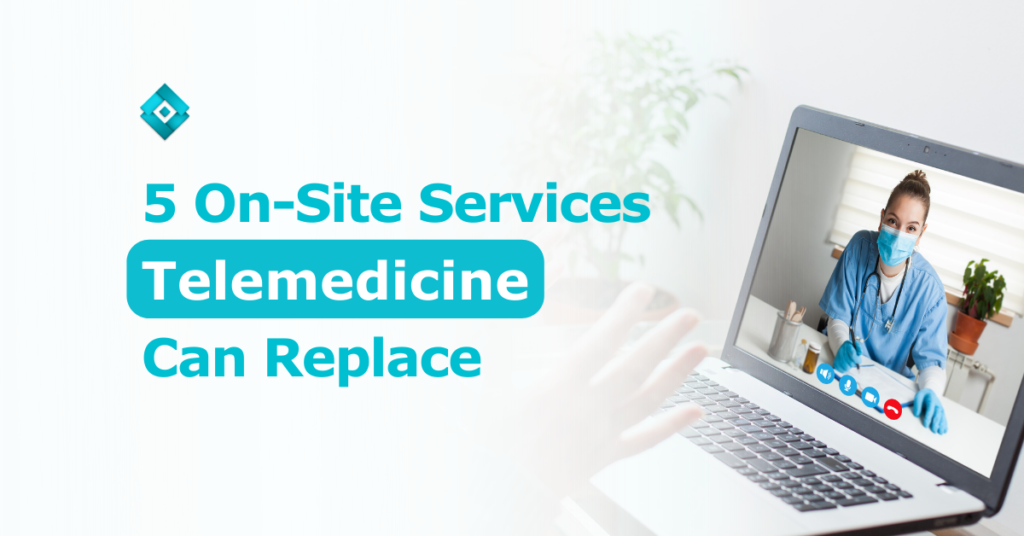Are there on-site services that telemedicine can replace? Yes!
There are on-site services that telemedicine can replace. It can actually be an excellent replacement for on-site services in some cases. Depending on the type of telemedicine service, it can provide the same quality of care as an on-site visit. Some of its benefits include less wait times and lower costs. So, if you want to transition telemedicine to your practice, here are five on-site services that telemedicine can replace.
What is Telemedicine?
Telemedicine uses telecommunication and information technologies to provide medical services from a distance. Consequently, it allows healthcare providers to deliver care to patients who cannot visit a doctor or hospital in person. As its purpose, Telemedicine intends to achieve various medical services such as consultation, diagnosis, and treatment of patients. You can also use it to provide educational programs and health information.
Meanwhile, medical practitioners like you need to keep your minds open to innovation such as Telemedicine. To expand your practice, save money and space, or bring accessible healthcare, you can decide which on-site services you prefer.
Here are few options of on-site services that telemedicine can replace.
1. Initial doctor visit
An initial visit aims to establish care with a new primary care physician. Here, the patient can already show a photo or a video of their concern through real-time telemedicine. This type of telemedicine uses video conferencing to consult with a physician. Additionally, patients can take advantage of asynchronous telemedicine or communicating through the use of secure messaging software. Lastly, patients can talk to their doctors about their symptoms without leaving their house. In turn, the doctor can already give their initial diagnosis. By replacing the initial doctor visit with Telemedicine, you can save time and energy by staying in your home.
2. Follow-up consultation
A follow-up consultation with your doctor is essential. A patient cannot remove this from their treatment plan. Here, physicians like you can check if the patient has had any side effects from the medicine or initial treatment. Thereafter, you can adjust the treatment or patients accordingly. Meanwhile, in a follow-up consultation using telemedicine, the provider and patient meet using a secure video conferencing program. Additionally, the provider can assess the patient’s progress, answer questions, and make necessary changes to the treatment plan.
Further, using telemedicine can be just as effective as an on-site visit. It can even be more convenient for both the provider and the patient. With it, you don’t need a huge space to accommodate patients. For patients, there’s no need to take time off work or find childcare before going to an on-site check up. Consequently, they can just log in to their doctor’s telemedicine software and have their consultation there. This is especially helpful in a situation where a working patient lives far away from their doctor. Ultimately, follow-up consultation using telemedicine can be a great way to maintain continuity of care with less hassle.
3. Managing chronic illnesses
Managing chronic illnesses by traveling to the doctor’s clinic can be one of the on-site services that telemedicine can replace. Through telemedicine, you can handle a chronic disease through Remote Patient Monitoring. This type of telemedicine utilizes technologies like applications and electronic trackers. Further, it uses other smart devices to keep the watch of patients even at a distance. It can be most helpful in treating older, high-risk, or patients with chronic pulmonary diseases, chronic kidney diseases, or hypertension. This is because these patients are delicate when they are exposed outside. For example, you can use it to monitor patients diagnosed with diabetes by tracking their sugar levels. Additionally, doctors can also employ it when they aim to collect patient data like weight, sleep patterns, and dietary routines.
Also, you can treat patients’ chronic diseases by communicating with the patient through a video call. In the call, you can assess the progress of the illness and make necessary changes to the treatment plan. This includes adjusting medications, scheduling follow-up appointments, or even referring the patient to specialists. As a result, telemedicine is an essential tool that can help improve chronic illness management.
4. Post-hospital care
Post-hospital care is a vital part of the recovery process for many patients. Unfortunately, it can be challenging to arrange on-site visits from a doctor or nurse, mainly if the patient lives in a remote area. Telemedicine can provide an alternative to on-site visits, allowing patients to receive the care they need without traveling and decreasing hospital visits.
With telemedicine, patients can discuss with their doctor or nurse using video conferencing and even receive some kinds of treatment remotely. Post-hospital care can also be serviced through asynchronous telemedicine, such as using messaging software like google mail, skype, or zoom where the patient can update the doctor on their condition. The doctor can adjust the treatment plan at a distance and even send prescriptions through telemedicine. Doing this is a convenient and cost-effective way to receive post-hospital care, and it can also help to reduce the risk of infection.
5. Doctor’s referral system
In recent years, telemedicine has become a promising solution to the problem of limited access to healthcare. A doctor’s referral system using telemedicine can be of great help in ensuring that patients get the best possible care. With this system, doctors can refer their patients to specialist doctors who can provide them with the most appropriate care. This way, patients can be assured that they will receive the best possible treatment for their condition. This can be done through a store-and-forward type of telemedicine which promotes better collaboration between medical practitioners. It involves utilizing a secured line to share the electronic medical records or results of patients and consult with each other. In addition, telemedicine can also help to speed up the process of getting appointments with specialist doctors. By using this system, patients can save time and money on travel and accommodation expenses.
Transitioning to Telemedicine
If your goal is to find a way to cut down on your costs or would like to offer a new service to your patients, then telemedicine may be the answer for you. As of today, there are many on-site services that telemedicine can replace. Telemedicine has been shown to be just as effective as in-person visits and can save you time and money. However, handling transition can be difficult, especially for an independent medical practitioner. But do not worry because Core Virtual Solutions can assist you during this change. Contact us today for a no-commitment free consultation so our industry experts can discuss how you can utilize telemedicine for your practice. Click here to schedule an appointment with us!








